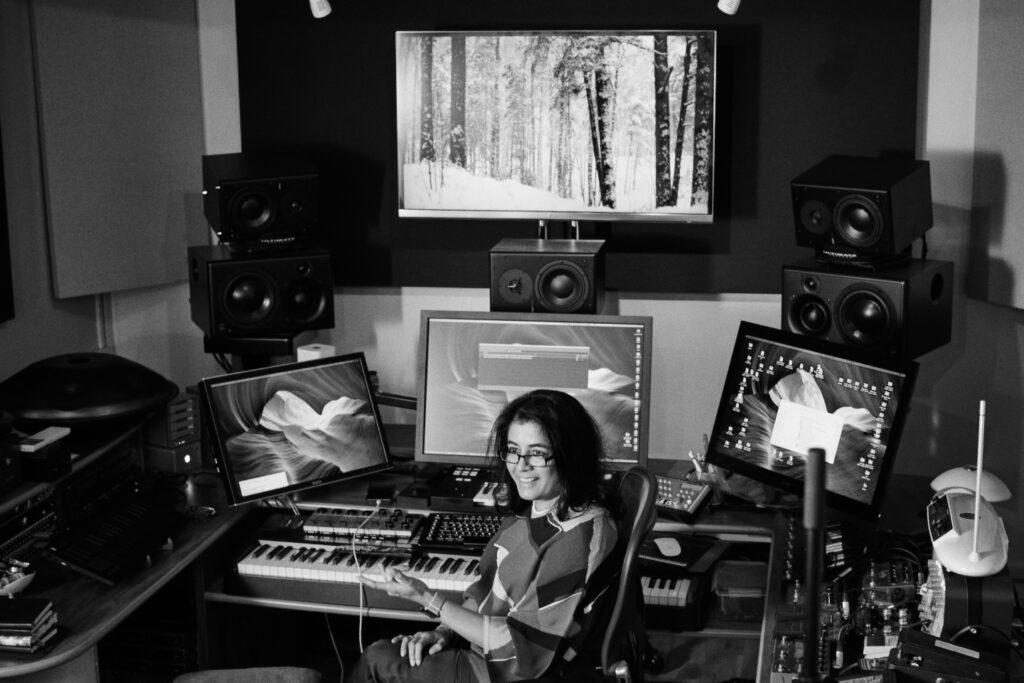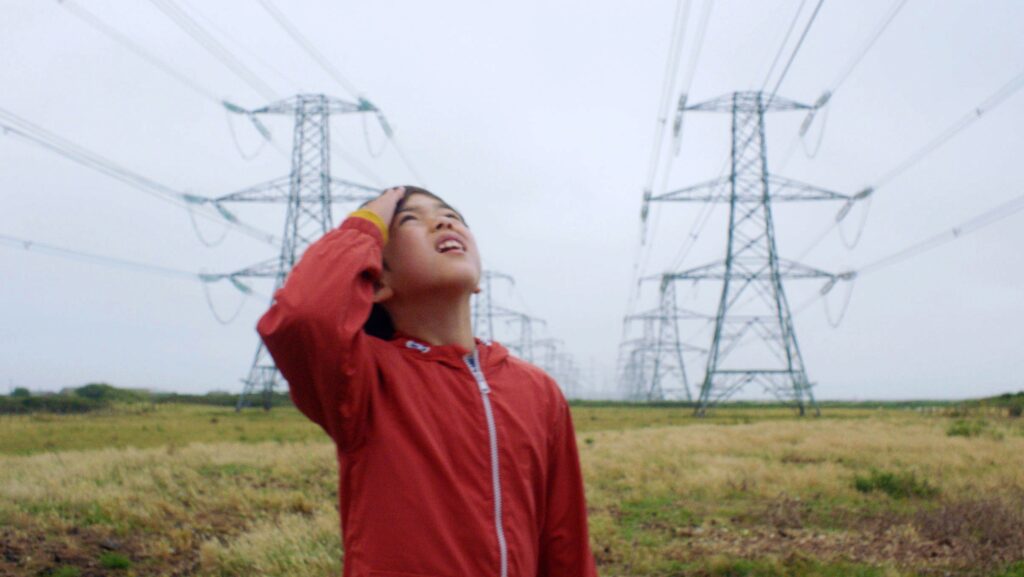If you haven’t heard of Nainita Desai, you’ll want to make a mental note. Winner of a BAFTA Breakthrough Brit award, chosen as the IFMCA’s Breakthrough Composer of 2019 and labelled by Film4 as one of the top five female composers who should be on your radar, she shows no sign of slowing down.
Desai’s best-known work includes the Oscar 2020 nominated film For Sama, the world-famous, hit Netflix show American Murder and the popular BBC drama series Unprecedented. Now, she talks to Outtake Magazine about her next big project, The Reason I Jump, a spellbinding documentary that seeks to educate audiences about the experiences of those with non-verbal autism.

Having already received great critical acclaim in the U.S. and winning the World Cinema Documentary audience award at the 2020 Sundance Film Festival, this highly anticipated documentary is finally making its way to U.K. cinemas.
Aside from the appeal of bringing people in and trying to educate them on non-verbal autism, were there other considerations that drew you to this project?
Nainita Desai: When the director, Jerry [Rothwell] first contacted me about it, I was immediately hooked by the amount of creative potential there, because of the way the autistic characters perceived the world around them has so much to do with sound. Their experiences are multi-sensory, and all the senses have this incredible assault on you as you are watching the film. So it’s not just the beautiful photography, but also the sound design and the music. It all has a place in trying to put you into the mind of the characters and into that world.
We knew from the outset that the director wanted me to create this cinematic, immersive experience, and we mixed it in Dolby 360 Atmos. We usually have something like 50 speakers in a cinema screen, so when you’re experiencing it, it puts you right in the middle of it – it’s incredibly experiential!
We experimented a lot. I was involved in the film for about 15 months, which is a long time to be committed to a single film project.
Wow! So you must have been there from start to finish?
Nainita Desai: Yeah. I was there from before they were filming, or had only done some early filming, and definitely before they started editing the film. I was writing a lot of music away from the images. I was very inspired by the original book and I had lots of creative dialogue with the director, editor ,and the sound designer. We were working very closely together and you don’t often get that opportunity on films – it tends to be a last-minute rush and you often have to work around the clock to get it finished on time.

We were doing a very intense process on this as well, but it was more of an exploratory, experimental journey that we went on. As much as the end result is what we are really aiming for, the journey was really interesting and that’s what I love about the kind of projects I’ve been privileged to work on recently.
Having watched The Reason I Jump ahead of this interview, I have to tell you how incredibly impactful and touching I found it. I hope you are incredibly proud of your work?
Nainita Desai: Yes, thank you. It’s lovely because everyone who’s watched it – that we’ve come across – has loved it and has just responded in such a positive way. I guess that’s why one works on these kinds of projects, you know, to connect with people emotionally and make them so much more aware of the subject in question, and the world.
Especially with these characters. To get them to understand what life is like as a non-speaking autistic, and to just be tolerant and have an open mind about people with autism. It’s an oft-misunderstood world, as you’ve seen in the film. Hopefully, The Reason I Jump sheds a light on what incredible people they are.
How did you use scoring in this film to bring these stories to life, especially considering some of the characters are non-verbal?
Nainita Desai: We went in with a lot of ideas and a lot of concepts, and some of them fell by the wayside while others really captured our imagination. In a fiction film you have characters and, musically, you can have themes for the characters. But we didn’t have that here – instead, we had concepts of autism and how the charters experienced the world.
Instantly we thought, wouldn’t it be great to use the human voice in the score and use it in a way that represents the internal voices of the characters? So what I did, for example, is I took some moments between Ben and Emma where they are using a letter boarding technique to communicate. When you see the letters coming up on screen to form words, we thought we’d have some musical cues where you hear the human voice actually singing the letters as it comes up on screen. That’s all my voice doing that!

There are other moments where the human voice is important, like in the scene with Amrit when she’s swaying backward and forwards with all the sounds of the ceiling and table fans going round and round. In that piece you go out of the rhythm of the fans, which blur and blend into a piece of music and subliminally you hear these vocals drifting in and out, building into a crescendo. The same thing happens with the young Higashida, who is drawn to the hum of electric generators, and to Joss, who listens to the sounds coming from the green boxes. In these scenes, the sound just grows and grows. It’s choral, this choir of voices.
We didn’t have the budget to hire a choir just for one piece, though, so I actually recorded my own voice about fifty times and layered it all on top of one another until you had this cacophony of voices. Then I treated and manipulated them in the computer to make myself sound like a whole choir. So we had a lot of fun experimenting with sounds that way. The human voice was really important, as was the idea of repetition.
What did you do to ensure The Reason I Jump was as authentic and accurate as it could be?
Nainita Desai: For me, authenticity is really important. Authenticity and integrity towards the subject matter, and the sensitivity of it. I brought in a cellist [Elisabeth Wiklander], a great musician who plays with the London Philharmonic Orchestra who is also autistic herself and a cultural ambassador for the National Autistic Association.
When she came to my studio to perform some of these pieces it was actually a really moving experience, because I would play her scenes and she would play the cello. And there was one scene in particular which talks about the second World War, when Nazi scientists were doing experiments on disabled people and it’s a really tough scene. She actually burst into tears because she, as an autistic person, could feel exactly what these characters were experiencing in the film. So it was a very moving project for both of us to work on.
I love researching and diving deep into these subjects and these films when I’m working on them, to ensure I do them justice.

It’s interesting you say that, because I was going to ask if the fact that these are real people and real stories affected how you approached the film? Did that responsibility weigh heavily on you?
Nainita Desai: Well, the obvious way was the book; I was so taken by the book when Jerry contacted me about it. Then we had lots and lots of discussions and as I mentioned, I love to do research: we listened to a lot of music and were inspired by lots of different types of music and sounds, and we’d exchange musical playlists just to try and find a way into the film.
I loved reading books and articles about the subject and seeing how sound and music affect those with autism, from a physiological and neurological point of view. That enabled me to come up with these abstract ideas and concepts like circular motion – like when we see Amrit rocking back and forth. A lot of autistic people will respond that way, they’ll latch onto the same thing and repeat themselves. I wanted to translate that into music by having little repeated elements like loops, rhythms and percussion going round and round.
I remember reading that you had used binaural audio. How does this change the viewing experience?
Nainita Desai: Yes. Truly the best way to experience this film is in the cinema. We has an amazing experience when we were in a Dolby Atmos theatre at Sundance Film Festival last year. Sadly, the film hasn’t been shown in a cinema since then, only at virtual film festivals. If you listen on headphones, then it’s really important that they be good headphones. The binaural sound design will really give you that immersive experience. It really is quite special!
What do you think working on this project has taught you?
Nainita Desai: Working on The Reason I Jump has taught me so much about how those with autism see the world. Over the course of the year, it’s really strange, but people have been coming out to me when I tell them about the project and going, “Oh I know so and so” who’s autistic, or they mention their son, or cousin, or niece. It just made me realise how many people are in the closet about it – they don’t want to talk about it. It’s all around us but it’s still a bit of a hidden world, and I think it’s important to shed a light on it.

Autistic people are not disabled. They don’t want to be seen that way, you know? They aren’t incompetent and just because they can’t speak doesn’t mean they don’t have a voice.
Other than this, are there any exciting projects you can tell us about?
Nainita Desai: Yes, it’s been a really busy year, and weaving in and out of this project I’ve also been working on quite a few other films. In fact, I’ve got another film coming out on HBO in America, hopefully in the U.K. soon. It’s another documentary feature called Persona [launched on 15th March] which is about the Myers Briggs personality tests. It’s a fascinating world! Musically the film is very different from anything I’ve ever done before. It’s a bit like Daft Punk: it’s all electronic synth waves, 1980s all-electronic score which is really upbeat and pop music-like.
I’ve got quite a few other things bubbling away, some amazing stories! There’s a film that I’m finishing off recording at Abbey Road in a couple of weeks. That’s a big string session. It’s a film called Nims, about a man called Nims Purja, who recently broke the world record for climbing fourteen of the world’s highest mountains in seven months. The film is full of thrills and danger and tension and drama. It’s got a big symphonic orchestral score. I just love the musical variety in terms of the genres. I have a thriller set in Israel/Palestine that I’ll be working on at the end of the year, and that’s going to be a lovely film to work on.
This interview originally took place February 2021.
The Reason I Jump will be available in Picturehouse cinemas in the U.K from 18th June 2021.
